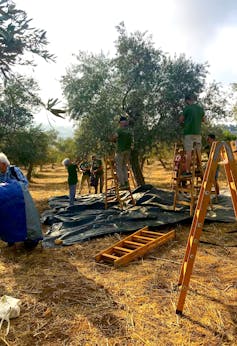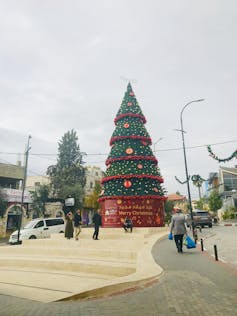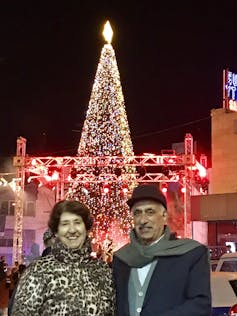By Dorina-Maria Buda | –
There are often marches and demonstrations in support of Palestine in cities around the world, but for those who want to visit the region, a thriving tourism industry has emerged in recent years. “Solidarity tourists” arrive at all times of year to help improve the lives of ordinary Palestinians, with events like olive tree planting in February and olive harvesting in October organised by local Palestinian initiatives such as the Alternative Tourism Group and Joint Advocacy Initiative
Given Palestine’s place in what is known as the Holy Land – the reputed birthplace of Jesus Christ – one of the busiest seasons for visiting is during the Christmas period. Despite the region’s troubled history, thousands make the trip each year.

Dorina Buda, Author provided
Many will take the Masar Ibrahim – meaning the path of Abraham – a 330km-long trail running from the north to the south of the Palestinian West Bank. Tourists are encouraged to stay with local families, as the hiking trail passes through more than 50 communities, including villages that are entirely Muslim, entirely Christian or with mixed communities.
Christmas in Palestine is a season for neighbourly relations among the various communities, and a period to tell stories of the ancestors. During the first week of December, most Palestinian towns light a communal Christmas tree, while local bands and choirs perform, and international tourists are encouraged to take part.
Since September 2019, I’ve been researching tourism in the Palestinian West Bank and trying to understand how people celebrate their ancient heritage amid modern tensions and conflict. This is my second Christmas in the region, and on both occasions I’ve had the opportunity to stay with a local family in Beit Sahour town, which is part of the Bethlehem area.
Peace and goodwill

Dorina Buda, Author provided
Few visitors realise that three Christmases are actually celebrated in Palestine. The Latin churches, which includes Catholic worshippers, recognise December 25 as Christmas Day. But the Greek Orthodox church, which represents the majority of Christians in Palestine and Israel, observes Christmas according to the old Julian calendar created during the time of Julius Caesar in 45 BC. For them, Christmas Day falls on January 7, while the Armenian Patriarchate of Jerusalem marks Christmas and Epiphany together on January 19.

Dorina Buda, Author provided
It’s still warm enough to go outdoors, so most visitors at this time of year will explore the beautiful Palestinian landscape. Hiking in the hills of Battir between Bethlehem and Jerusalem takes tourists through a UNESCO heritage site, while in the north part of the country near Ramallah, the hills of Birzeit offer charming views of valleys and hillsides. Christmas markets are also popular and for children, there’s the traditional practice of decorating the al-burbara, a Palestinian dessert, at the Bethlehem Peace Center in celebration of Saint Barbara’s Day on December 4.
Violence flared after US President Donald Trump recognised Jerusalem as Israel’s capital in December 2017. According to one hotel manager in Palestine’s West Bank, the cancellation rate for bookings that month was around 80%. Palestine’s tourism industry seemed to recover in 2018, but the conflict can have a lasting impression that serves to turn away potential tourists.
Local authorities are quick to denounce the risk and insist that Palestine is safe to visit. Anton Salman, the mayor of Bethlehem said:
Bethlehem as a tourist destination is a secure and safe place. We are showing to the world with the lighting of the Christmas Tree ceremony that Bethlehem is a safe place … Tourists can visit and they can have the experience together with Bethlehemites, ours is a welcoming, hospitable community.
Tour guides also seem optimistic about demand from visitors. Yamen Elabed from Beit Sahour has worked as a tour guide for the past ten years and said:
I have not seen such a busy November in a long time. Compared to the same months in 2018, the number of tourists has increased significantly.
I spoke with one tourist from the US who praised the “amazing” hospitality of the local people. Even amid the turmoil and conflict, the friendly welcome of Palestine is an example to the world.![]()
Dorina-Maria Buda, Professor of Tourism Management, Leeds Beckett University
This article is republished from The Conversation under a Creative Commons license. Read the original article.
Featured photo: Bethlehem Peace Centre and Christmas tree, December 2019, by Dorina Buda.



 © 2026 All Rights Reserved
© 2026 All Rights Reserved